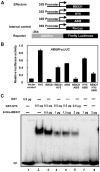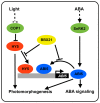Convergence of Light and ABA signaling on the ABI5 promoter
- PMID: 24586210
- PMCID: PMC3937224
- DOI: 10.1371/journal.pgen.1004197
Convergence of Light and ABA signaling on the ABI5 promoter
Abstract
Light is one of the most important environmental cues regulating multiple aspects of plant growth and development, and abscisic acid (ABA) is a plant hormone that plays important roles during many phases of the plant life cycle and in plants' responses to various environmental stresses. How plants integrate the external light signal with endogenous ABA pathway for better adaptation and survival remains poorly understood. Here, we show that BBX21 (also known as SALT TOLERANCE HOMOLOG 2), a B-box (BBX) protein previously shown to positively regulate seedling photomorphogenesis, is also involved in ABA signaling. Our genetic data show that BBX21 may act upstream of several ABA INSENSITIVE (ABI) genes and ELONGATED HYPOCOTYL 5 (HY5) in ABA control of seed germination. Previous studies showed that HY5 acts as a direct activator of ABI5 expression, and that BBX21 interacts with HY5. We further demonstrate that BBX21 negatively regulates ABI5 expression by interfering with HY5 binding to the ABI5 promoter. In addition, ABI5 was shown to directly activate its own expression, whereas BBX21 negatively regulates this activity by directly interacting with ABI5. Together, our study indicates that BBX21 coordinates with HY5 and ABI5 on the ABI5 promoter and that these transcriptional regulators work in concert to integrate light and ABA signaling in Arabidopsis thaliana.
Conflict of interest statement
The authors have declared that no competing interests exist.
Figures










References
-
- Rizzini L, Favory JJ, Cloix C, Faggionato D, O'Hara A, et al. (2011) Perception of UV-B by the Arabidopsis UVR8 protein. Science 332: 103–106. - PubMed
-
- Yi C, Deng XW (2005) COP1-from plant photomorphogenesis to mammalian tumorigenesis. Trends Cell Biol 15: 618–625. - PubMed
-
- Osterlund MT, Hardtke CS, Wei N, Deng XW (2000) Targeted destabilization of HY5 during light-regulated development of Arabidopsis . Nature 405: 462–466. - PubMed
-
- Koornneef M, Rolff E, Spruit CJP (1980) Genetic control of light-inhibited hypocotyl elongation in Arabidopsis thaliana (L.). Heynh Z Pflanzenphysiol 100: 147–160.
Publication types
MeSH terms
Substances
LinkOut - more resources
Full Text Sources
Other Literature Sources
Molecular Biology Databases

